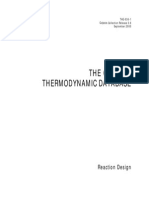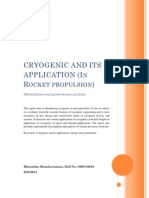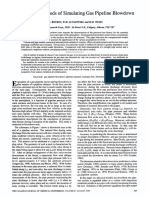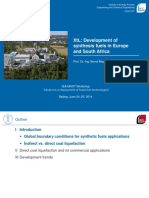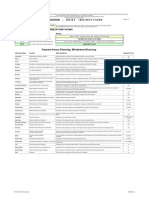X.S. Bai Turbulent Premixed Flames
X.S. Bai Turbulent Premixed Flames
Uploaded by
Ika WidyasariCopyright:
Available Formats
X.S. Bai Turbulent Premixed Flames
X.S. Bai Turbulent Premixed Flames
Uploaded by
Ika WidyasariOriginal Description:
Original Title
Copyright
Available Formats
Share this document
Did you find this document useful?
Is this content inappropriate?
Copyright:
Available Formats
X.S. Bai Turbulent Premixed Flames
X.S. Bai Turbulent Premixed Flames
Uploaded by
Ika WidyasariCopyright:
Available Formats
Lecture 8.
Turbulent Premixed Flames
X.S. Bai Turbulent premixed Flames
Content
• Feastures of turbulent premixed flames
• Mechanisms of flame wrinkling
• Regimes of turbulent premixed flames
• Turbulent burning velocity
• Propagation of turbulent flames in flow field
• Turbulent premixed flame stabilization
X.S. Bai Turbulent premixed Flames
Experimental setup: Low swirl burner
Filtered Rayleigh Scattering setup
X.S. Bai Turbulent premixed Flames
Results - simultaneous PIV / PLIF
The combined PIV / OH-PLIF results
showing the flame front structure and
its position in the flow field.
X.S. Bai Turbulent premixed Flames
PLIF of fuel
X.S. Bai Turbulent premixed Flames
PLIF of fuel and OH
X.S. Bai Turbulent premixed Flames
Premixed jet flames
D outer
ceramic
holder
Do=22mm
Di=2.2mm
D inner
methane/air
(outer)
methane/air
(inner)
X.S. Bai Turbulent premixed Flames
Laminar flame
photo CH2O CH
Vo=0.45 m/s, phi=1.17; Vin=11m/s, phi=1.1
X.S. Bai Turbulent premixed Flames
Turbulent jet flame
photo CH2O CH
Vo=0.45 m/s, phi=1.17; Vin=120m/s, phi=1.0
X.S. Bai Turbulent premixed Flames
The shape of a turbulent premixed flame: a closer look
• Planar single pulse OH radical
concentration, 50mm above the
burner. Field size: 150x110 mm
• natural gas/air premixed flame
measured by Buschmann et al (26th
symp. Comb., pp.437, 1996)
• OH peak denotes the flame zone. Why
flame zone is wrinkled? See next slide
X.S. Bai Turbulent premixed Flames
Lean H2/air premixed flame in a room
door
Lean
H2/air mixture
X.S. Bai Turbulent premixed Flames
Lean H2/air premixed flame in a room
X.S. Bai Turbulent premixed Flames
Basic features of TPF
• TPF can be divided to three zones
– Preheat zone
– Reaction zone
– Postflame zone
• The reaction zone in typical TPF is thin
– CH layer;
– fuel consumption layer
• The reaction zone is highly wrinkled
– Due to turbulence eddies
– Due to self-instability
• Hydrodynamic instability (Landau-Darrieus)
• Diffusion-thermal instability
• Bouyancy effect (Rayleigh-Taylor)
X.S. Bai Turbulent premixed Flames
Wrinking by turbulence eddies
X.S. Bai Turbulent premixed Flames
Flame – turbulence interaction and
regimes turbulent premixed flames
X.S. Bai Turbulent premixed Flames
Different scales in turbulent premixed flames
• Flow scales
– Mean flow scales
• Length (L), velocity (U), time (t=L/U)
– integral scales
• length (l0), velocity (v0=u(l0)), time (τ0= l0 /v0),
– Kolmogrov scales
• length (η), velocity (vη=u(η)), time (τη= η /vη),
• Flame scales
– flame speed (SL)
– flame thickness (δL)
– time scale (tc)
• flame thickness/flame speed
• chemical reaction time
– the flame structure may not be laminar
X.S. Bai Turbulent premixed Flames
Physical interpretation of length, time and velocity scales
Chemical reaction and flame scales
preheat zone oxidation layer 2000
0.2 1800
T
inner layer 1600
temperature (K)
0.15
mole fraction
1400
0.1 O2 1200
1000
0.05 CO2
C3H8 800
CO
0 600
−2 −1 0 1 2
flame coordinate (mm)
X.S. Bai Turbulent premixed Flames
Physical interpretation of length, time and velocity scales
Mean flow scales
alpha U
SL = U sin(alpha)
SL
Flow time >> molecularmixing time
X.S. Bai Turbulent premixed Flames
Physical interpretation of length, time and velocity scales
Turbulence eddy scales
X.S. Bai Turbulent premixed Flames
Physical interpretation of length, time and velocity
scales
Turbulence eddy scales
Eddy size – l
Eddy velocity – ul
Eddy turn over time – teddy=l/ul
Molecular mixing time of
Material of size lk – tmixing=lk2/D=lk/uk
teddy l uk
ul = = Rel 1 / 2
l tmixing ul l k
note : lk = η, uk = u η
X.S. Bai Turbulent premixed Flames
Physical interpretation of length, time and velocity
scales
inlet, other Energy transfer at a
boundaries ‘constant’ rate ε
heat
δL
ul
l
X.S. Bai Turbulent premixed Flames
Turbulent jet flame
photo CH2O CH
Vo=0.45 m/s, phi=1.17; Vin=120m/s, phi=1.0
X.S. Bai Turbulent premixed Flames
Turbulent jet flame
PLIF images of
formaldehyde (green)
and CH (red) in
laminar (a) and
turbulent (b-f) flames
with different gas
supply speeds in the
inner tube.
X.S. Bai Turbulent premixed Flames
Scale relationship
inlet, other Energy transfer at a
boundaries ‘constant’ rate ε
heat
⎛ l 0 ⎞⎟
2/3
v0 v η3
3
τ0 l0 vη
ε∝ ∝ ⇒ ∝ ∝ ⎜⎜ ⎟⎟
l0 η τη v0 η ⎜⎝ η ⎠⎟
vη η vl
∝ 1 ⇒ 0 0 ∝ Rel 0
ν vη η
l 0v 0 ⎛⎜ η ⎞⎟
1/ 3
l0 l0 v0 vη
∝ ∝ ⎜⎜ ⎟⎟
η η vη v0 ν ⎝ l 0 ⎠⎟
l0 v τ
⇒ ∝ Rel 0 3 / 4 ; 0 ∝ Rel 01/ 4 ; 0 ∝ Rel 01/ 2 ;
η vη τη
X.S. Bai Turbulent premixed Flames
Non-dimensional numbers
in turbulent premixed flames
v 0l 0
Reynolds number Rel 0 =
ν
Damköhler number τ0 l0 S L
Da = =
τc v 0 δL
Karlovitz number
δL δL D v η η ⎛⎜ δL ⎞⎟
2
τc δL v η
Ka = = = = ⎜ ⎟⎟
τη SL η S L δL ν ηη ⎜⎝ η ⎠⎟
Turbulent intensity
v0
TI =
SL
X.S. Bai Turbulent premixed Flames
Non-dimensional numbers
Reynolds number
v0 l0
Re l =
ν
∴ S L ∝ (D ⋅ rr ) , δ L ∝ (D / rr ) , S Lδ L ∝ D ∝ ν
1/ 2 1/ 2
v0 l0
v0 l0 v0 l0
Re l = ∝ ∝
ν D S Lδ L
⎛ v0 ⎞ ⎛ l0 ⎞
⇒ log ⎜⎜ ⎟⎟ = log (Re l ) − log ⎜⎜ ⎟⎟ Constant Rel lines in the
⎝δL ⎠
Borghi-diagram
⎝ SL ⎠
X.S. Bai Turbulent premixed Flames
Borghi-diagram
Rel=104
Constant Rel lines
Rel=100
⎛ v0 ⎞⎟ ⎛ l0 ⎞⎟
log ⎜ ⎟⎟ = log (Rel ) − log ⎜⎜ ⎟⎟
⎜
⎜⎝S ⎠⎟ ⎝⎜ δ ⎠⎟
L L
Rel=1
X.S. Bai Turbulent premixed Flames
Non-dimensional numbers
Damköhler number
τ0 l0 S L
Da = =
τc v 0 δL
l0 v0
log(Da ) = log( ) − log( )
δL SL
X.S. Bai Turbulent premixed Flames
Da=0.01 Borghi-diagram
Constant Da lines
Da=1
Da=100
l v
log(Da ) = log( 0 ) − log( 0 )
δL SL
Rel=1
X.S. Bai Turbulent premixed Flames
Non-dimensional numbers
Karlovitz number
τc δL v η δL l 0 v η u ′ δL u ′ l 0 v η
Ka = = = =
τη SL η S L l0 η u ′ l0 S L η u ′
δL u ′ δL 1/ 2 u ′ 3 / 2
= Rel 0 = ( ) ( )
1/ 2
l0 S L l0 SL
u′ 1 l0 2
log( ) = log( ) + log(Ka )
SL 3 δL 3
X.S. Bai Turbulent premixed Flames
Borghi-diagram
Ka=100
Constant Ka lines
Ka=1
u′ 1 l 2
log( ) = log( 0 ) + log(Ka )
SL 3 δL 3
Rel=1 Ka=0.01
X.S. Bai Turbulent premixed Flames
Borghi-diagram
Ka=100
dark region: GT engines
small circle: GE LM6000
squares: VR-1
I: laminar flames
II: wrinkled flamelet
III: corrugated flamelet
IV: thin reaction zone
V: distributed reactions
X.S. Bai Turbulent premixed Flames
Flamelet regimes
δL δL D v η η ⎛⎜ δL ⎞⎟
2
τc δL v η
Ka = = = = ⎜ ⎟⎟ < 1
τη SL η S L δL ν ηη ⎜⎝ η ⎠⎟
• The thickness of reaction zone + preheat zone is thinner than the Kolmogrov
scale, i.e. δL<η
– Tranport of mass and heat between the reaction zone and preheat zone is
by molecular mixing
– As a good approximation the local flame propagates at laminar flame
speed and the thickness of the flame is laminar
burned
mKolmogrov u(η) D δ u(η)η
Unburned ∼ / 2 ∼ L
mreaction ,all _ layers δL δL η D
δL
∼ <1
η
X.S. Bai Turbulent premixed Flames
Turbulent jet flame
PLIF images of
formaldehyde (green)
and CH (red) in
laminar (a) and
turbulent (b-f) flames
with different gas
supply speeds in the
inner tube.
X.S. Bai Turbulent premixed Flames
Thin reaction zone regime
δ δ D v η η ⎛⎜ δL ⎞⎟
2
τ δ v
Ka = c = L η = L L = ⎜ ⎟⎟ ,1 < Ka < 100
τη SL η S L δL ν ηη ⎜⎝ η ⎠⎟
burned
Reactant pockets
Unburned May not pass the
Inner layer of
The reaction zone
mKolmogrov u(η) u(η) D δ u(η)η mkolmogrov u(η) S L δ u(η)η
∼ /Ω ∼ / 2 ∼ L ∼ / ∼ inn
mreaction ,all −layers δL δL δL η D mreaction ,inner _ layer δL δin η D
δL δinn δ
∼ >1 ∼ ∼ 0.1 L ∼ 0.1Ka 1 / 2 < 1
η η η
X.S. Bai Turbulent premixed Flames
Turbulent jet flame
PLIF images of
formaldehyde (green)
and CH (red) in
laminar (a) and
turbulent (b-f) flames
with different gas
supply speeds in the
inner tube.
X.S. Bai Turbulent premixed Flames
Distributed reaction zone regime
δ δ D v η η ⎛⎜ δL ⎞⎟
2
τ δ v
Ka = c = L η = L L = ⎜ ⎟⎟ , Ka > 100
τη SL η S L δL ν ηη ⎜⎝ η ⎠⎟
burned Reactant pockets
May pass the
Unburned
Reaction zone
Without full
consumption
mKolmogrov u(η) D δ u(η)η mkolmogrov u(η) S L δ u(η)η
∼ / 2 ∼ L ∼ / ∼ inn
mreaction ,all _ layers δL δL η D mreaction ,inner _ layer δL δin η D
δL δinn δ
∼ >1 ∼ ∼ 0.1 L ∼ 0.1Ka 1 / 2 > 1
η η η
X.S. Bai Turbulent premixed Flames
How does TPF propagate
• TPF propagates due to
– Heat transfer to preheat zone to heat up the fuel/air to above
’cross-over’ temperature
– Fuel/air mass transfer to the reaction zone to provide fuel/air
for combustion and releasing heat
• Transport of mass and heat between the reaction zone and the
preheat zone
– can be different from laminar premixed flames
– Depending on the thickness of the zones
X.S. Bai Turbulent premixed Flames
Turbulent burning velocity
X.S. Bai Turbulent premixed Flames
Turbulent burning velocity
• Also called turbulent flame speed
• Defined as the propagation speed of the mean flame front, relative
to the unburned mixture
• Is equal to the consumption rate of the unburned mixture (volume
flow per unit area of the mean flame front)
X.S. Bai Turbulent premixed Flames
Turbulent burning velocity: flamelet regime
• Also called turbulent flame speed
• Defined as the propagation speed of the mean flame front, relative
to the unburned mixture
• Is equal to the consumption rate of the unburned mixture (volume
flow per unit area of the mean flame front)
AL
sT
AM
unburned burned
side side
sL
low-intensity, large
η
scale
X.S. Bai Turbulent premixed Flames
Turbulent burning velocity: flamelet regime
ST / S L = 1 + u ′ / S L
ST / S L
Flamelet
Fall-off
theory
∼ 10 − 100 u′ / S L
X.S. Bai Turbulent premixed Flames
Turbulent burning velocity: thin reaction zone regime
ST / S L ∼ Dt / D ∼ u ' 0 / ν = Re
1/ 2
0
ST / S L
Flamelet
Fall-off
theory
∼ 10 − 100 u′ / S L
X.S. Bai Turbulent premixed Flames
Burning velocities
• Laminar burning velocity
– Depending on Molecular diffusion
– Depending on Chemical reactions
– Independent of flow
• Turbulent burning velocity
– Depending on Molecular diffusion
– Depending on Chemical reactions
– Depending on flow
X.S. Bai Turbulent premixed Flames
Propagation of turbulent premixed flames
Propagation of the instantaneous flame front
∂G
+ v ⋅ ∇G = S L ∇ G
∂t
Propagation of the mean flame front
ST
∂G
+ v ⋅ ∇G = ST ∇G
SL ∂t
X.S. Bai Turbulent premixed Flames
Mean planar flame in a tube
Unburned ST U
burned
x< 0
x> 0
x= 0 (at t=0)
x
• Stable flame Flame position
• Flashback
• Blowoff x = (U − ST )t
• Quenching distance
X.S. Bai Turbulent premixed Flames
Mean conical flame
G(x,r,t)=0
U
x
R r
ST
U 2 − ST 2
x = (R − r)
ST 2
Rim stablization
U Liftoff
Blowoff
flashback
X.S. Bai Turbulent premixed Flames
Flame stabilization
Zst
Temperature field
and streamlines
Ssgs v (white) from LES
Schematic of the conical burner
X.S. Bai Turbulent premixed Flames
Flame stabilization
X.S. Bai Turbulent premixed Flames
AEV burner
Between 1990 and 2005, all new gas turbines of ABB (later Alstom/Siemens) have
Implemented EV burners.
ABB/Alstom EV burner
X.S. Bai Turbulent premixed Flames
AEV burner: flame stabilization by swirling flow
X.S. Bai Turbulent premixed Flames
Swirl combustor, dump combustor, bluff-body stabilization
X.S. Bai Turbulent premixed Flames
You might also like
- Introduction To Combustion Concepts and Applications 3rd Edition Turns Solutions ManualDocument42 pagesIntroduction To Combustion Concepts and Applications 3rd Edition Turns Solutions ManualAl JawadNo ratings yet
- Vietnam National Standard TCVN 5687: 2010Document1 pageVietnam National Standard TCVN 5687: 2010hoang nguyenNo ratings yet
- Chemkin Fitdata PDFDocument40 pagesChemkin Fitdata PDFHasan Kayhan KayadelenNo ratings yet
- Steinmueller Engineering Produktbroschuere Steam GenerationDocument7 pagesSteinmueller Engineering Produktbroschuere Steam GenerationTC Capulcu Mustafa MNo ratings yet
- Review of Kinetic and Equilibrium Concepts For Biomass Tar Modeling by Using Aspen PlusDocument22 pagesReview of Kinetic and Equilibrium Concepts For Biomass Tar Modeling by Using Aspen PlusserchNo ratings yet
- Transat Particles in PipesDocument17 pagesTransat Particles in Pipesمحمد توفيق عراقيNo ratings yet
- Asme GT2005-68799 PDFDocument9 pagesAsme GT2005-68799 PDFJeeEianYannNo ratings yet
- Unit 5 Sulphur Recovery Unit PDFDocument32 pagesUnit 5 Sulphur Recovery Unit PDFMohamed AdelNo ratings yet
- The Process Piping: Introduction To Ori Ce FlangeDocument6 pagesThe Process Piping: Introduction To Ori Ce FlangeMohamed AdelNo ratings yet
- Compressors BrochureDocument8 pagesCompressors BrochureRanto GunawanNo ratings yet
- Punch List: 1798-PL-FCB-27 Fabcon Industrial Services FZ LLC ITT-1798 Daelim 19441-1798-2-R0 19441-1798-2-R0Document3 pagesPunch List: 1798-PL-FCB-27 Fabcon Industrial Services FZ LLC ITT-1798 Daelim 19441-1798-2-R0 19441-1798-2-R0Brain AliveNo ratings yet
- Jzi BrochureDocument24 pagesJzi Brochuremumbojumbo1No ratings yet
- Callidus Flares Brochure PDFDocument5 pagesCallidus Flares Brochure PDFNurul Atiqah Ahmad KamalNo ratings yet
- 2017 Oxyboost-Technology - Paper-London - MarchDocument8 pages2017 Oxyboost-Technology - Paper-London - MarchAlberto TousNo ratings yet
- 1798 2235 RC 1 TQ 46 PDFDocument1 page1798 2235 RC 1 TQ 46 PDFBrain AliveNo ratings yet
- GDocument11 pagesGbillNo ratings yet
- Furnace Heater DesignDocument7 pagesFurnace Heater DesignMubashir fareedNo ratings yet
- P810213 PDFDocument5 pagesP810213 PDFAnonymous kejOID9QsNo ratings yet
- Hinds Errata Text BookDocument9 pagesHinds Errata Text BookJorn DoeNo ratings yet
- Steam Reformer: Created in COMSOL Multiphysics 5.4Document30 pagesSteam Reformer: Created in COMSOL Multiphysics 5.4Rizky KusumastutiNo ratings yet
- AT 03609 WP Dehydration With Aspen HYSYS PDFDocument25 pagesAT 03609 WP Dehydration With Aspen HYSYS PDFVictor Miguel Diaz JimenezNo ratings yet
- POWER Magazine - May 2023-1Document43 pagesPOWER Magazine - May 2023-1MarcialgonzalezpNo ratings yet
- Chemical Engineering Science: K. Papadikis, S. Gu, A.V. BridgwaterDocument10 pagesChemical Engineering Science: K. Papadikis, S. Gu, A.V. Bridgwatershoemakerlevy9No ratings yet
- Integration of Gasification With Thermal Residue Conversion in RefineriesDocument15 pagesIntegration of Gasification With Thermal Residue Conversion in Refineriesrameshkarthik810No ratings yet
- Install Vru S651torage TanksDocument9 pagesInstall Vru S651torage TanksNacho.pNo ratings yet
- Computational Fluid Dynamics: MSC / Pgcert / PgdipDocument34 pagesComputational Fluid Dynamics: MSC / Pgcert / PgdipJon CsehiNo ratings yet
- 13.30 Lummus JohnZink Zero Carbon Fuels For Steam CrackersDocument25 pages13.30 Lummus JohnZink Zero Carbon Fuels For Steam Crackers4Chat GptNo ratings yet
- SCR and CO Catalyst Requirements-Ken Jeffers, Johnson MattheyDocument35 pagesSCR and CO Catalyst Requirements-Ken Jeffers, Johnson MattheyJoseph Riley100% (1)
- Driving Expander TechnologyDocument24 pagesDriving Expander TechnologysajadranjbaranNo ratings yet
- Chapter 3 - Materials Selection Process: See Also Chp.2 of Ashby's TextDocument22 pagesChapter 3 - Materials Selection Process: See Also Chp.2 of Ashby's TextHasby AsNo ratings yet
- C2X To Build Large-Scale Green Methanol Production For Multiple IndustriesDocument2 pagesC2X To Build Large-Scale Green Methanol Production For Multiple IndustriesFatima BahticNo ratings yet
- Mechanical Design of A Low Cost Parabolic Solar Dish ConcentratorDocument11 pagesMechanical Design of A Low Cost Parabolic Solar Dish ConcentratorArunsinghNo ratings yet
- Cryogenic and Its ApplicationDocument11 pagesCryogenic and Its ApplicationBhoomika MansharamaniNo ratings yet
- Torrefaction of Indonesian Sugar-Cane Bagasse To Improve Bio-Syngas Quality For Gasification ProcessDocument10 pagesTorrefaction of Indonesian Sugar-Cane Bagasse To Improve Bio-Syngas Quality For Gasification ProcessGhulam MurtazaNo ratings yet
- Enclosed Ground Flares: Zero Smoke, Low Noise and No Visible FlameDocument4 pagesEnclosed Ground Flares: Zero Smoke, Low Noise and No Visible FlameT. LimNo ratings yet
- Models Methods Simulating Gas Pipeline Blowdown (1989) - KK Botros Et AlDocument11 pagesModels Methods Simulating Gas Pipeline Blowdown (1989) - KK Botros Et AlbeenolandNo ratings yet
- BLOOM ENERGY Final PresentationDocument6 pagesBLOOM ENERGY Final PresentationAlagappan AngamuthuNo ratings yet
- Modeling of Black Liquor Gasification in Bubbling Fluidized Bed Presentation)Document20 pagesModeling of Black Liquor Gasification in Bubbling Fluidized Bed Presentation)api-3799861No ratings yet
- R-501 Uneven Bed TemperaturesDocument35 pagesR-501 Uneven Bed TemperaturesTalal AshrafNo ratings yet
- Correctly Modeling and Calculating Combustion Efficiencies in Fired EquipmentDocument23 pagesCorrectly Modeling and Calculating Combustion Efficiencies in Fired Equipmentfawmer61No ratings yet
- Internal Carbon Loop Strategy For Methanol Production From Natural Gas - Multi-Objective Optimization and Process EvaluationDocument14 pagesInternal Carbon Loop Strategy For Methanol Production From Natural Gas - Multi-Objective Optimization and Process EvaluationVinicius dos Santos MirandaNo ratings yet
- John Zink - ATTACH H VCU Catalogs Leaflets (Brochure)Document8 pagesJohn Zink - ATTACH H VCU Catalogs Leaflets (Brochure)Pedro Ferrugem KaiserNo ratings yet
- Decarbonize The Natural GasDocument4 pagesDecarbonize The Natural GasGabriel ColmontNo ratings yet
- BR-1833 - B&W - A Comparison of Fluid-Bed Technologies For Renewable Energy Applications PDFDocument7 pagesBR-1833 - B&W - A Comparison of Fluid-Bed Technologies For Renewable Energy Applications PDFEduardo DreifusNo ratings yet
- 3 3 MR Robert PardemannDocument47 pages3 3 MR Robert Pardemannhoremheb1No ratings yet
- DME Synthesis Technology Ready For Market: © Gastech 2005Document6 pagesDME Synthesis Technology Ready For Market: © Gastech 2005yan energiaNo ratings yet
- Modeling & Simulation of Secondary ReformerDocument8 pagesModeling & Simulation of Secondary ReformerChuma KhanNo ratings yet
- PDFDocument123 pagesPDFPrakash WarrierNo ratings yet
- Fischer TropschDocument47 pagesFischer TropschHoracio RodriguezNo ratings yet
- Haldor Topsoe PDFDocument28 pagesHaldor Topsoe PDFSlamet Purwadi S.TNo ratings yet
- Models - Chem.multicomponent Tubular ReactorDocument23 pagesModels - Chem.multicomponent Tubular ReactorHectorNo ratings yet
- Neft 2Document32 pagesNeft 2Roozbeh PNo ratings yet
- Thermo-Economic Performance Comparison of Two Configurations ofDocument17 pagesThermo-Economic Performance Comparison of Two Configurations ofSallyNo ratings yet
- Session: NH Fuel Use: Facilitator: Bill DavidDocument24 pagesSession: NH Fuel Use: Facilitator: Bill Davidkwayneolson6081No ratings yet
- Flare Reduction Project Family: October 2009Document67 pagesFlare Reduction Project Family: October 2009dragos_n66No ratings yet
- Thesis Syed AbbasDocument263 pagesThesis Syed AbbasabubakarNo ratings yet
- Multiphase Reactor Engineering for Clean and Low-Carbon Energy ApplicationsFrom EverandMultiphase Reactor Engineering for Clean and Low-Carbon Energy ApplicationsYi ChengNo ratings yet
- Laminar Premixed FlamesDocument84 pagesLaminar Premixed FlamesKoharudin SyahNo ratings yet
- Peter Longo 1994Document12 pagesPeter Longo 1994phd.meethaqNo ratings yet
- Droplet EvaporationDocument10 pagesDroplet EvaporationUfuk BaslamisliNo ratings yet
- Start Up Procedure For Alkylation Unit WithDocument10 pagesStart Up Procedure For Alkylation Unit WithBikas SahaNo ratings yet
- Bogey CurvesDocument9 pagesBogey CurvesGaneshmohite123No ratings yet
- Calorimetry Practice Problems WS2Document2 pagesCalorimetry Practice Problems WS2April CasaoNo ratings yet
- VRF York 2017Document44 pagesVRF York 2017NPUIUNo ratings yet
- Solution Report For: Home My Test My ProfileDocument13 pagesSolution Report For: Home My Test My ProfileSanjay SudhakarNo ratings yet
- HT Lecture 05 FinsDocument40 pagesHT Lecture 05 FinsAbdullah AhmedNo ratings yet
- Panchal 2017Document26 pagesPanchal 2017ritikNo ratings yet
- Nuclear Engineering and Design: Diego Castelliti, Guglielmo LomonacoDocument12 pagesNuclear Engineering and Design: Diego Castelliti, Guglielmo LomonacoIsma-MANo ratings yet
- Hto EniDocument4 pagesHto EniChintan GondaliaNo ratings yet
- J. R. Simonson (Auth.) - Engineering Heat Transfer-Palgrave Macmillan UK (1988)Document280 pagesJ. R. Simonson (Auth.) - Engineering Heat Transfer-Palgrave Macmillan UK (1988)Glasst Innovacion 2019100% (2)
- Comparison of Formulae For Determining Heat Transfer Coefficient of Packed BedsDocument7 pagesComparison of Formulae For Determining Heat Transfer Coefficient of Packed BedsDurairaj SankaranNo ratings yet
- Multi Effects DesalinationDocument18 pagesMulti Effects Desalinationabrar3831100% (1)
- Physics Heat-EnglishDocument2 pagesPhysics Heat-EnglishGoogle AccountNo ratings yet
- UNIT III - Thermal Physics MCQDocument8 pagesUNIT III - Thermal Physics MCQomnamovenkatesaya369No ratings yet
- Heat Transfer MCQsDocument29 pagesHeat Transfer MCQsSalah ElaydiNo ratings yet
- Thermal Diffusivity Measurements On Insulation Materials With The Laser Flash MethodDocument10 pagesThermal Diffusivity Measurements On Insulation Materials With The Laser Flash Methodspow123No ratings yet
- PHPP2007 English DemoDocument57 pagesPHPP2007 English DemoSrinivas SukhavasiNo ratings yet
- Springer ZEMCH Book 2016 Chapter8 Altan Et AlDocument30 pagesSpringer ZEMCH Book 2016 Chapter8 Altan Et AlSURJIT DUTTANo ratings yet
- Absorption Refrigeration System Using Engine Exhaust GasDocument28 pagesAbsorption Refrigeration System Using Engine Exhaust GasPradeep Kadamat33% (3)
- Convection and Radiation Heat TransferDocument14 pagesConvection and Radiation Heat TransferSalman ShalwaniNo ratings yet
- 2023 Applied Thermal EngineeringDocument13 pages2023 Applied Thermal EngineeringChandrasekaran NNo ratings yet
- Lab Report 2 - Cooling TowerDocument14 pagesLab Report 2 - Cooling TowerSeng Kong0% (2)
- Tutorial 18 - Heat Transfer - TeapotDocument11 pagesTutorial 18 - Heat Transfer - Teapot염규정100% (1)
- Radiation Fundamental 2: Surface Radiative PropertiesDocument20 pagesRadiation Fundamental 2: Surface Radiative PropertiesRashed KaiserNo ratings yet
- ICSE Board Class 8 Physics Syllabus PDFDocument15 pagesICSE Board Class 8 Physics Syllabus PDFBhushan KalgaonkarNo ratings yet
- Under Demonstration Project of ECBC Cell - Uttarakhand: Techno FeasibilityDocument22 pagesUnder Demonstration Project of ECBC Cell - Uttarakhand: Techno FeasibilityChiddharth FenixNo ratings yet
- Sustainable Energy Technologies and AssessmentsDocument13 pagesSustainable Energy Technologies and AssessmentsMuhammadAsimNo ratings yet
- Performance and Improvement of Cleanroom Environment Control System Related To Cold-Heat Offset in Clean Semiconductor FabsDocument13 pagesPerformance and Improvement of Cleanroom Environment Control System Related To Cold-Heat Offset in Clean Semiconductor Fabsqac gmpNo ratings yet
- Kirloskar Ebara-An Overview 1Document4 pagesKirloskar Ebara-An Overview 1ravikpclNo ratings yet


